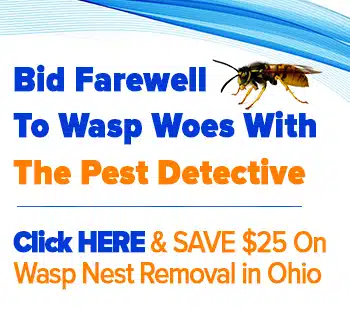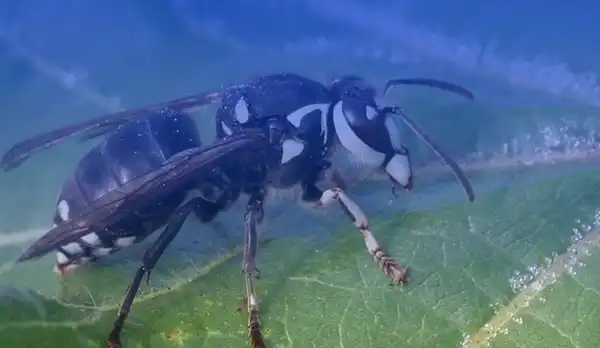
Your Crucial Guide to the 12 Common Wasps in Ohio
Written & Edited By:
Last Update: August 3, 2024 – 10:30AM ET
There are hundreds of different species of wasps in Ohio, many of which are attracted to places where they may not be welcome. These intruders often form nests, leading to infestations and annoyances. The key to preventing unwanted nests is understanding what attracts wasps in Ohio and the environmental conditions they need to thrive. Hi, my name is John, and I am The Pest Detective! With years of experience as an exterminator, I find joy in sharing my in-depth knowledge of pests with fellow Ohioans, including the various species of wasps. In this article, I’ll cover all of the common wasps in Ohio and include images so you can identify them quickly.
Jump To Section: 1.Bald-Faced Hornets 2.European Paper Wasp 3.Eastern Yellowjacket 4.Dark Paper Wasp 5.Metric Paper Wasp 6.Yellow Legged Mud Dauber Wasps 7.German Yellowjackets 8.Red Paper Wasp 9.Cicada Killer Wasps in Ohio 10.Black Wasps in Ohio 11.Mason Wasps 12.Great Golden Digger Wasps
When Are Wasps in Ohio Active?
Wasps in Ohio are active between April and October when temperatures are optimal for peak wasp activity. They prefer to come out towards the middle of the day when it is warm, and they are less active in the early morning and towards dusk as temperatures drop. After the outside temperature drops below 53 degrees, wasps lose strength and begin to fly sluggishly.
Nearly all wasps in Ohio sting and those with wasp allergies should be extremely cautious around them. Removing wasp nests can be dangerous without proper protection. If you need any assistance with wasp extermination in Ohio feel free to call The Pest Detective at (216)-758-0603 to have a professional at your doorstep the same day.
Read on to learn about all common wasps in Ohio!
1. Bald Faced Hornet
–Dolichovespula maculata
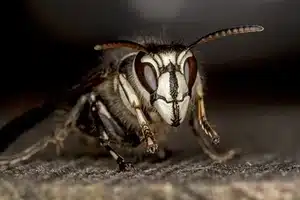
Wait….. what? I thought this was about Wasps in Ohio not hornets! Well, despite its name, this highly aggressive wasp is not a hornet. Bald Faced Hornets are known as one of the most common wasps in Ohio. This species can be found in paper nests typically found at least three feet above the ground in shrubs, eaves of houses, trees, porches, and utility poles. Bald-Faced Hornets are known for their white markings and extremely painful stings. People often find themselves swarmed after unknowingly disturbing the nest during lawn care. These are one of the only types of black wasps in Ohio, and they can be distinguished by their black body with white markings.
Think you have real hornets? Check out our article Hornets in Ohio
Related: Wasp Extermination
2. European Paper Wasp
–Polistes dominula

The European Paper Wasp originated in Germany and spread throughout the world due to accidental importing by humans. These Ohio wasps form large paper nests that can be found on the eaves of houses, overhangs, and trees. In some cases, they have been known to form a nest inside abandoned holes from animals. Although these wasps in ohio are not particularly aggressive, they are known to vigorously defend their nests when a life-threatening situation arises. Nests often have upwards of 3000 workers, and the larger ones can house up to 8000.
Related: Spotted Lanternfly Ohio: Whats All The Fuss?
3. Eastern Yellowjacket
–Vespula maculifrons
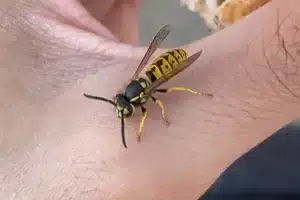
This common species of Ohio wasps form nests in the ground, often in abandoned holes from moles, groundhogs, and other burrowing animals. They are extremely aggressive and do not require agitation of the nest before stinging. Individuals who approach the nest within just a few feet may find themselves swarmed and stung repeatedly. The Eastern Yellowjacket’s painful sting carries a venom that results in an allergic reaction in some people, requiring immediate medical attention.
4. Dark Paper Wasp
–Polistes spp
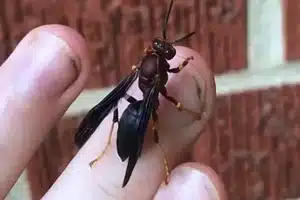
“Polistes spp“
The Dark Paper Wasp is one of the most common wasps in Ohio. They can be identified by their yellow legs and dark body. Dark Paper Wasps form umbrella-shaped nests out of a material that looks like paper which is what separates paper wasps from other types. These wasps are very aggressive, and territorial of their nests. A sting leaves an allergic reaction in some people and may require medical attention.
5. Metric Paper Wasp
–Polistes metricus
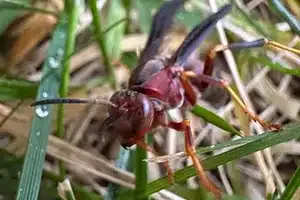
Metric Paper Wasps in Ohio are aggressive and they are known to sting when agitated. Don’t confuse it with the Red Paper Wasp in Ohio, these wasps are identified by the mostly red thorax and dark-colored wings. Metric Paper Wasp legs have contrasting colors of yellow, red, and black. Their nests are cone-shaped and made of a paper-like substance. The main characteristic that this wasp is identified with is swelling in the abdomen below the thin yellow stripe.
Related post: Wolf Spiders of Ohio
6. Yellow Legged Mud Dauber Wasp
–Sceliphron caementarium
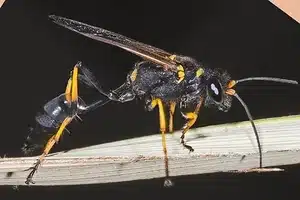
These wasps in Ohio are known for the cylindrical nests they create out of mud, often in the eaves of buildings and houses. Yellow-legged Mud Dauber Wasps in Ohio prey on spiders which are then brought inside the nest for larvae to feed on. These wasps can also be found feeding on the liquid inside hummingbird feeders (2). Yellow-legged mud Dauber Wasps in Ohio can be identified by an elongated body with a narrow abdomen and yellow legs, however, some populations in southern states may lack the yellow coloring.
Get expert help: Wasp Exterminator Near Me
7. German Yellowjacket
–Vespula germanica
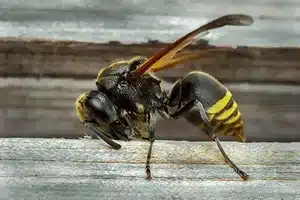
The German Yellowjacket is considered an invasive species of wasps in Ohio. These wasps are known to nest in attics and between the walls of houses in Ohio. Due to their apparent preference for nesting in manmade structures, they pose a serious threat to the health of the public. German Yellowjackets became a widespread issue in the southwestern United States after they were brought here from Europe and Northern Africa in the 1970s, they slowly spread throughout the country after this. Colonies rapidly increase in size, and in the worst cases they can grow up to 14 feet in length by 4 feet in width. German Yellowjackets are notoriously territorial and become extremely aggressive when the nest is agitated. Each hive has a network of guards with the sole purpose of protecting the nest, these guards emit a scent that causes the hive to swarm and sting the agitator when the nest is in danger.
8. Red Paper Wasp
–Polistes spp
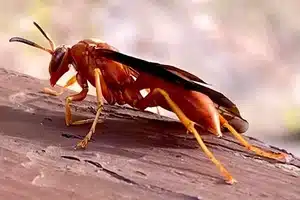
“Polistes spp”
Red Paper Wasps are named after their red-orange colored body and jet-black wings. These common wasps in Ohio form gray-colored nests in the eaves of houses and sheds, and sometimes in smaller voids like outdoor grilles. Although Red Paper Wasps are not particularly aggressive, they do sting when agitated. These Red Wasps in Ohio start their nest off small and grow rapidly after becoming established. They prey on caterpillars which are then brought back to the nest for larvae to feed on, adult Red Paper Wasps in Ohio feed on nectar from flowers.
Related: Does Bleach Kill Bed Bugs? Everything You Need To Know
9. Cicada Killer Wasp
–Sphecius specius
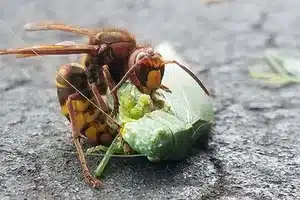
Cicada Killer Wasps in Ohio form their nests in the ground. Openings are one-half an inch in diameter which allows the dead Cicada to fit through. These nests have Cicadas spread throughout the chambers. After Cicada Killer Wasps in Ohio lay their egg inside a chamber, they will leave at least one Cicada inside the chamber and seal off the opening, this provides enough food for the larvae to survive until pupation which is a process that takes about two weeks. Cicada Killer Wasps in Ohio can be found in grassy areas where the soil is properly humid.
Here’s the pricing you can expect for Wasp Extermination: How Much Does An Exterminator Cost
10. Great Black Digger Wasp
–Sphex pensylvanicus

These wasps in Ohio can be identified by their noticeably large, bluish-black body and black wings. Great Black Digger Wasps form nests in the ground which have chambers, and each chamber is assigned one egg and one paralyzed insect to feed on once hatched. These black wasps in Ohio are generally not aggressive however the females can give a painful sting if they feel threatened. Males do not have a stinger. Nests are often found near gardens so that the adults can collect nectar and pollen during the day.
11. Four Toothed Mason Wasp
– Monobia quadridens
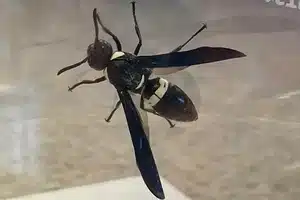
Four Toothed Mason Wasps are often found in the late summer and early fall. They are not a very territorial species and often stay away from humans, but they will sting if threatened. These black wasps in Ohio are often mistaken for Bald-Faced Hornets, however, they can be separated by the lack of white facial markings. Adults are commonly found on flowers where they drink their primary food source nectar, and they feed caterpillars to the larvae.
Related post: Cockroaches in Ohio
12. Great Golden Digger Wasp
–Sphex ichneumoneus
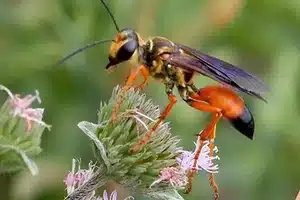
Great Golden Digger Wasps in Ohio are solitary which means they are not aggressive. These wasps can be identified by the golden hairs on the head and thorax paired with a reddish-orange color abdomen and legs. Adults feed on nectar and the young feed on crickets, katydids, and grasshoppers that are paralyzed and brought back to the nest by adults. The females are tasked with digging tunnels within the nest and creating more wasps. Great Golden Digger Wasps in Ohio find themselves vulnerable to predators, specifically birds that steal their paralyzed prey.
Get the help you need! View our pest control services for expert solutions.
Preventing Wasps in Ohio
Preventing wasps from forming nests on your property can often be done by removing some specific things from the area. Typically you will want to remove any source of water from the area, bird baths and other standing water are particularly attractive housing amenities for wasps in Ohio. We recommend sealing up any cracks and voids in the exterior structure to prevent wasp nests from forming on the property as well. The best course of action to prevent wasps is to have the perimeter of the structure treated by a pest management specialist such as The Pest Detective.
FAQ
Bald-faced hornets have the most painful sting of all wasps in Ohio, and they sting repeatedly until the nest is no longer threatened. Additionally, they are extremely territorial which often results in the victims being aggressively swarmed by the nest after approaching it too closely. If you come across a Bald-faced hornet nest, be sure to keep your distance and contact a professional for removal!
Eastern Yellowjackets form nests in the ground and they are also one of the most common wasps in Ohio. These underground nests are often located under shrubs, logs, trees, and other locations protected from the sun and rain. Nests are often discovered when performing lawn care, homeowners will unknowingly mow or weed-wack over it causing the agitated bees to swarm the perpetrator.
The Cicada Killer Wasp is by far the largest wasp in Ohio, and coming across one of them can be pretty alarming. Cicada Killer Wasps are slightly larger than the European Hornet, and these two species are often mistaken for each other because of their impressive size and similar colors. However, they can easily be identified because the Cicada Killer Wasp nests in the ground, while European Hornets form paper nests above the ground.
If the nest is located in a place where people are often present and could be stung, quickly taking action against a wasp nest is the best way to ensure the safety of family members and guests. Most wasps in Ohio are highly territorial which puts you and your guests at risk each time the nest is approached. If people allergic to wasps are common visitors, we recommend having the nest removed by a professional immediately and performing preventive treatments each spring.
Managing Wasps in Ohio
With many wasps in Ohio, you should be concerned about your guests or family being stung by a wasp. Bald Faced Hornets, Yellowjackets, and Paper Wasps are highly defensive of their nest and will often sting people if they approach the nest without knowing it’s there. After discovering a wasp nest you should notify people who may come in contact with it. We always recommend hiring a pest control company in Ohio with a proper beekeeping suit to protect themselves. Many at-home wasp control products are not effective and often leave the homeowner with several stings.

